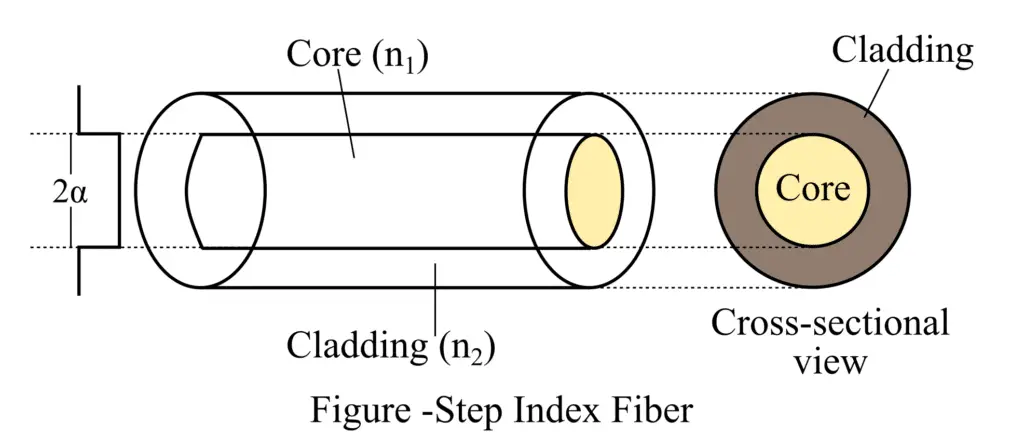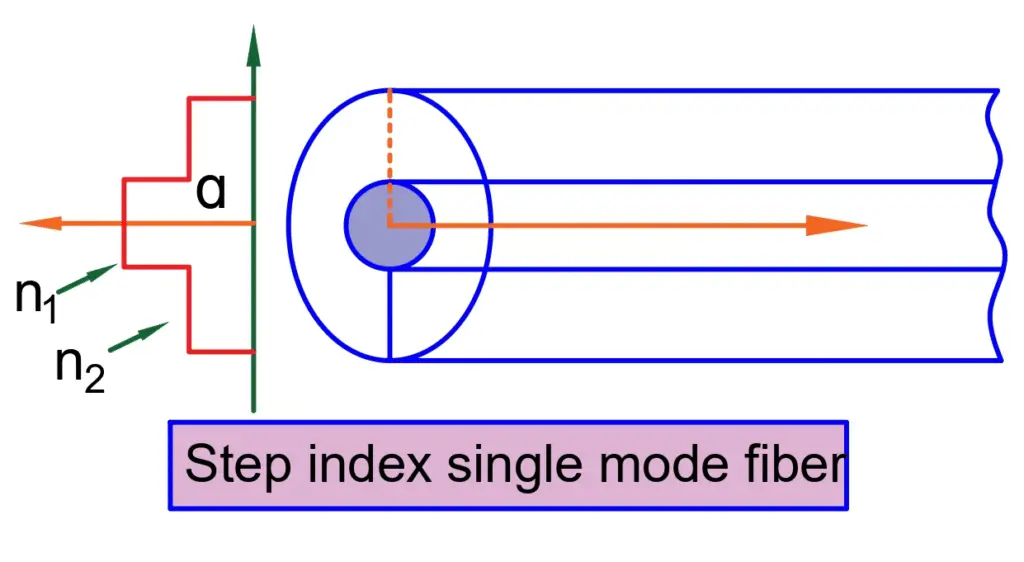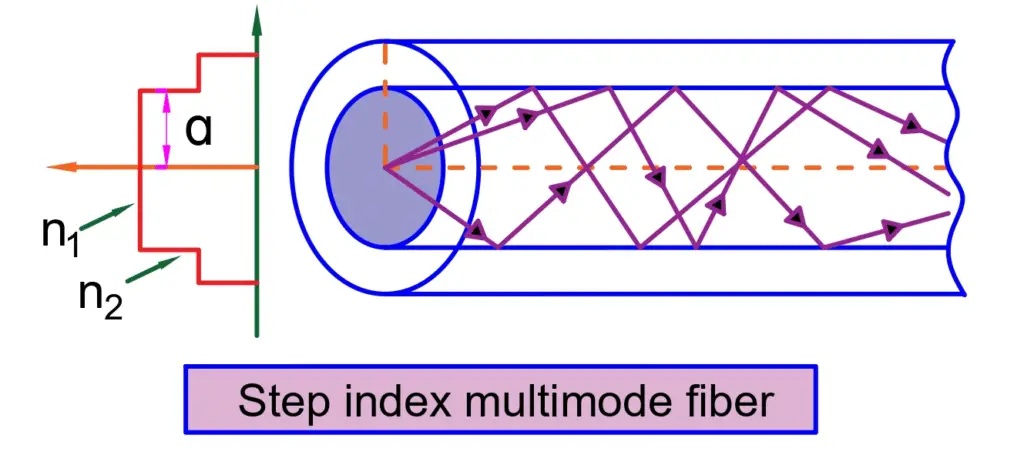Step index fiber is a type of optical waveguide that has a constant refractive index of the core and cladding, but the value of the refractive index of both core and cladding is different.
In this article, we will discuss the definition, construction, modes, advantages, and applications of step index fiber. So, let’s start with the basic definition of it
What is Step Index Fiber?
It is a type of optical fiber that has a constant and uniform refractive index within the core and a sharp change in the refractive index at the contact point of the core and cladding. Therefore, its core has a uniform refractive index and the cladding has another uniform refractive index. Consequently, a sudden variation in the refractive index is seen at the core-cladding interface.
Its core has a higher refractive index as compared to that of the cladding surrounding it. This variation in the refractive index of the core and cladding allows the optical fiber to transmit light signals more effectively over long distances.
The schematic diagram of the step-index fiber profile is depicted in the following figure.

It consists of two major parts namely, core and cladding. The core is the central part of the fiber and cladding is the outer part. The core carries the light signals while the cladding surrounds the core to confine the light signal within the fiber.
Here, when a light signal travels through the fiber, it follows a zigzag path due to the difference in the refractive index of the core and cladding. Although, the resultant of these zigzag paths is a straight line due to total internal reflection.
The following mathematical expression provides information about the refractive index,

Where r is the radial distance, and a is the radius of the core.
Modes of Step Index Fiber
In the context of step index single mode fiber, modes mean paths through which light propagates through the fiber. The number of modes depends on the diameter of the core of the fiber and the difference between the refractive index of the core and cladding.
Depending upon the number of modes, step index fibers are of two types namely single mode and multimode.
Single Mode Step Index Fiber
A single-mode step index fiber has only one path for light propagation. It has a core of smaller diameter which is typically around 2 µm to 15 µm. Due to this small core diameter, only one path for light propagation is possible. The transmitted ray through this fiber does not distort because a single light ray propagates through the fiber.
The below figure shows the propagation of light rays through fiber.

This fiber has a very low core diameter, between 2 µm to 15 µm, and it is suitable for single-mode propagation.
The significant advantage of this fiber is that it has higher bandwidth, allowing high information-carrying capacity. It is also suitable for long-distance transmission due to its low modal dispersion. Although, the cost of this fiber is relatively higher as compared to multimode fiber.
Multimode Step Index Fiber
A multimode step index fiber has multiple paths or modes for light propagation along the channel. It has a relatively larger core diameter, typically around 50 µm or larger, and it permits multiple modes to propagate through it. It means it can propagate several light rays down the fiber.
The major advantages of multimode fiber include low cost and simple fabrication. However, it has a lower information-carrying capacity due to high modal dispersion. The high dispersion is caused by the propagation of multiple light rays at a time and further, it causes a delay in propagation time., Therefore, multimode fiber is usually used in short-distance communication.
The below figure shows the propagation of light rays through a multimode optical fiber.

We can see in the above figure that the core diameter is large and it permits multiple propagation paths. The core size is between the size of 50 to 1000 µm.
Advantages of Step Index Fiber
The following are the major advantages.
- It involves simple and easy design and manufacturing procedures.
- it has a constant and uniform refractive index within the core.
- it allows efficient light signal propagation due to its sharp variation in refractive index at the core-cladding interface.
- Highly cost-effective in terms of manufacturing and application.
- Robust against mechanical stresses and movements.
- Highly versatile; hence it is suitable for a wide range of applications.
Disadvantages of Step Index Fiber
Step index fiber has several advantages, though it also has some disadvantages. Some major disadvantages are listed below:
- It is not suitable for applications where high bandwidth and high information-carrying capacity is required.
- It suffers from modal dispersion that reduces the bandwidth and transmission distance of the fiber.
- It suffers from mode coupling and modal noise that affect the signal quality.
Applications of Step Index Fiber
It is widely used in data communication. Some common applications are listed below:
- It is widely used for short-distance data communication like in LAN.
- Used in measuring instruments and sensor-based applications.
- Used in research and development applications due to its low cost.
- It is also used in fiber optic-based lighting systems for cost-effective illumination of a specific area.